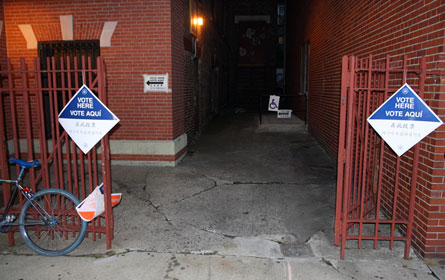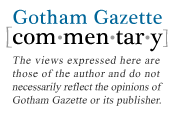
The results from the primary elections on Sept. 15 were remarkable in two respects for those who worry about the health of democracy in New York.

The electorate showed some spunk, or at least a measure of restiveness, rejecting five City Council incumbents in their bid for re-election. When you take a look at each race where the incumbent lost, it is easy enough to identify weaknesses. Each district has its own story, a blend of foible and miscalculation on the part of the incumbent, against the backdrop of the poor economy. It is also important to note that four of the ousted incumbents followed the lead of Mayor Michael Bloomberg and Speaker Christine Quinn and voted to extend term limits last year (the fifth loser, Kenneth Mitchell from Staten Island, was not in office at the time of the vote). Many voters are still sour about the decision of the city's political establishment to change by local law what many voters viewed as an issue they had settled on in two referenda many years before.
Local politics is usually about getting a nice big slice of the pie for your neighborhood -- saving a fire house, some parking spots, or building a park or school -- but last month's election suggested that something quite different was in the air. The game is not just all about winning, but being fair. The decision to throw out term limits sticks in the collective throat of New Yorkers. That's the good news -- voters upset about process.
The second remarkable aspect of the election was the turnout. The final number is not in yet, but between 10 percent and 12 percent of registered Democrats came out on Sept. 15 to cast a vote. In last week's runoff primary for city comptroller and public advocate, the turnout was even lower, a little less than 8 percent. This is a startlingly low number. In the November 2008 general election (Barack Obama v. John McCain) 50 percent of all registered voters came out to vote; in the February Democratic primary for the presidential nomination (Obama v. Hillary Clinton) 33 percent of Democrats showed up.
The vitality of last year's political season has drained away. Recall that when the state legislature moved control of the city schools to the mayor in 2002, one of the most compelling arguments for changing the system was that local community school boards no longer worked, in part because no one was voting for members of the board. Voting percentages in school board contests in many neighborhoods often dipped into the same range as the turnout reported in the recent primary. Will the current system of closed primary elections in New York one day suffer from a crisis in legitimacy that we saw with school board elections? It certainly is tracking that way.
It is not just the fact that roughly 2.5 million Democrats stayed home. Another 711,000 independents (17 percent of all voters) are ineligible to vote to any closed party primary. About 482,000 Republicans and 130,000 third party registrants cannot participate in the all-important Democratic primary too. So, we are left with about 8 percent of the total registered electorate picking the local legislature in the closed Democratic primary election on September 15, since the winners are virtually a lock to win the general election races in all but three of the 51 districts in the November general election
The Case for Nonpartisan Elections
Francis Barry makes the case in The Scandal of the Reform that nonpartisan elections can bring the franchise back to voters who are not registered Democrats. "Why," he asks, "exclude independent voters from the first round of voting [the closed primary] if that is the decisive election?" Messy empirical and practical arguments aside, this is a compelling argument on its face. As new generations of voters entering the polity valuing their independence and refusing to commit to one political party or the other, the numbers of the effectively disenfranchised will only climb.
Most cities have nonpartisan elections; Los Angeles, Chicago and Miami are among the larger ones on the list. Municipal elected officials in nonpartisan cities still participate in partisan politics; Los Angeles mayor Antonio Villaraigosa is a stalwart Democrat who is plotting a run for governor in his party's primary. In another nonpartisan city, Jersey City, Mayor Jerramiah Healy ran with the backing of the Hudson County Democratic machine. A point that is often lost is that nonpartisan election schemes can vary greatly; some cities allow candidates to identify themselves as partisans, others do not.
Bloomberg likes nonpartisan elections too, but he focuses more on the managerial quality of local government, along the lines of Fiorello LaGuardia's old chestnut that there is no partisan way to pick up the garbage. In 2003, Bloomberg established a charter commission under the chairmanship of Frank Macchiarola, the president of St. Francis College, to investigate and make recommendations for a nonpartisan election plan for the city. The commissioners worked hard, but faced overwhelming opposition from "reform" groups in New York. (I use the quotations here because Barry is not buying into the conventional nomenclature.)
Bloomberg's charter commission recommended giving candidates the option of indentifying their party affiliation if they chose, but opening the election to all registered voters, thus eliminating the closed party primary. If you are concerned about a crowded election contest that will produce a winner with 10 percent to 15 percent of the vote, no worries -- we can employ instant runoff techniques where voters can select their second and third choices. The top finishers can be paired off with the additional preferences supplied by voters and a winner with a legitimate majority can be crowned. (For more on instant runoff voting, see The Wonkster.)
Voters overwhelmingly rejected Macchiarola's plan for nonpartisan elections, 70 percent to 30 percent. But only 13 percent of registered voters bothered to show up for the off-year election of 2003, and many had ties to the unions, interest groups and political clubs that benefit from the status quo and know how to pull the levers of the current system to their advantage. They were loathe to expand the electorate and risk the surrender of power.
The Limits of 'Reform'
In a style reminiscent of the restaurant scene in Goodfellas in which we are introduced to Henry Hill's partners in crime in an extended panning shot, Barry describes a fundraiser in South Street Seaport for NYPIRG where he indentifies the good government players who came to pay their respects. The crowd at the fundraiser included the leadership of NYU's Brennan Center, Common Cause, the League of Women Voters and the Citizens Union -- almost all of them liberal Democrats. (Citizens Union's sister organization, Citizens Union Foundation, publishes Gotham Gazette.) Barry argues that the city's reform community is more interested in advancing a liberal Democratic policy agenda than in process questions -- putting the living wage before ballot access, so to speak -- and the reform groups are more than willing to accommodate the city's incumbents and political insiders to get the job done.
"Good government leaders preach the virtues of process purity until that process works against them," writes Barry. "Then they break their own rules and hope no one notices." The city's public interest groups may cloak themselves in the language of the common good, but by Barry's lights they are just pigs at the city's trough, slopping up power and influence.
It was not always this way. In the age of Tammany, good government groups advocated the nonpartisan ballot as a method of combating the corruption of the political machines, even as they often surrendered to their nativist impulses and sought to restrict citizenship and ballot access. But Barry is no fan of the old-fashioned progressives, and he appreciates the way the county organizations brought immigrants into the political system.
Barry argues that things took a really bad turn when the mass politics base of the county organizations and political clubs began hollowing out after World War II -- the rank and file stopped going to meetings and making decisions. Political consultants become the new party bosses, and today elected officials try to build small machines devoted to their reelection and advancement. These new, candidate-centered machines are devoted to keeping people off the ballot with arcane petitioning procedures, rather than expanding the choices for voters and the electorate itself. And the good government groups are largely quiet about it.
Barry works for Bloomberg and served on the staff of the several charter commissions that considered the proposals for nonpartisan elections. Much of this hard work is evidenced in the book, as he demolishes conventional arguments in political science that claim that partisan elections mobilize voters and encourage minority voting. This political science folklore is based on a few dusty studies that are decades-old. Political scientists have been trained to love the theory of strong party government -- it is a tough habit to break.
Barry's work is full of wisdom about local politics. His well-written history of the machine/reform dynamic over the last 150 years is balanced and fair. He casts a critical eye on the city's campaign finance system, arguing that it has not increased political competition. One campaign operative told me, cracking wise, that the program should be renamed the printers and consultants relief act. The generous public matching system has lined the pockets of the political professionals, but has not increased political competition in any structural way. Anyone who got a stack full of useless campaign junk mail this fall sees their tax dollars at work.
Barry says that nonpartisan elections very well might create a more cooperative spirit in City Hall, and embolden rank and file legislators to break with orthodoxy. I am not so sure -- many cities, after all, have nonpartisan municipal elections and are just slogging it out like we do in the Big Apple. The best case for the adoption of nonpartisan elections is the principled one, removed from any impact it may have: Nonpartisan elections give more people the opportunity to exercise, in a meaningful way, the most fundamental right and obligation in a democracy, the vote.
Richard Flanagan is associate professor of political science at the College of Staten Island and co-directs the Center for the Study of Staten Island there. He is co-author of Staten Island Politics: Conservative Bastion in a Liberal City (forthcoming).




